Food grade silicone is a type of material that is commonly used in food storage containers, bakeware, and cooking utensils.
It is important to ensure that any silicone products that come into contact with food are labeled as “food grade”, as this ensures that they meet strict standards for safety and purity.
Food grade silicone is made from a combination of silica, carbon, hydrogen, and oxygen. Unlike many other materials that can leach harmful chemicals into food, silicone is completely non-toxic and does not release any harmful substances even when it is exposed to high temperatures.
This makes it an excellent choice for food storage containers, baking sheets, and cooking utensils that will be used on a regular basis.
In addition to its non-toxicity, food grade silicone has several other important benefits.
For example, it is extremely flexible and can be easily molded into a wide variety of shapes and sizes, making it ideal for food storage containers that can be easily packed in a lunchbox or stored in a pantry.
Is Silicone BPA Free?
Yes, silicone is considered to be BPA-free. This means that it does not contain the chemical, and therefore does not pose the same health risks associated with BPA exposure.
This is because silicone is a completely different type of material that is not derived from petrochemicals, which is the source of many plastics and BPA.
It’s important to note, however, that not all silicone products are created equal. To ensure that you are using a truly BPA-free product, it is important to look for products that are specifically labeled as “food grade” or “food safe.”
This indicates that the product has been tested and certified to meet strict safety standards, and that it is safe for use with food and in the kitchen.
Silicone in Food
The importance of non-toxic kitchen appliances cannot be overstated, especially since harmful materials in the kitchen can have serious health implications. When choosing kitchen appliances, it is essential to know how to identify non-toxic options. For instance, using products made from food-grade silicone can provide a safe alternative to materials that may be harmful.
Food-grade silicone is made with ingredients that are approved by the FDA for use in food and is free from toxic chemicals such as lead, cadmium, and phthalates.
Despite its many benefits, some people remain skeptical of silicone’s safety. However, there is no scientific evidence to support the idea that silicone is harmful to human health. In fact, the FDA has deemed food-grade silicone safe for use in food and kitchen products.
It’s important to note that not all silicone products are created equal. To ensure that you are using a safe product, it’s crucial to look for products made from food-grade silicone and to avoid products made from lower-quality silicone.
You can also check the product for an FDA or SGS (Societe Generale de Surveillance) certification, which indicates that the product has been tested and found to be safe for food use.
Food Grade Silicone Applications
Food-grade silicone is a type of silicone that is safe for use in food and food storage applications. Some common food-grade silicone applications include:
- Bakeware: Silicone baking mats, muffin cups, and loaf pans are popular due to their non-stick properties and heat resistance.
- Cooking Utensils: Silicone spatulas, cooking utensils, and kitchen tools are safe for use with food and do not scratch cooking surfaces.
- Food Storage: Silicone food storage bags and containers are airtight and help to keep food fresh.
- Baby Products: Silicone baby bottles, sippy cups, and teething toys are popular due to their non-toxic properties and durability.
- Ice Cube Trays: Silicone ice cube trays are flexible and easy to remove ice cubes from.
- Cake Decorating: Silicone cake molds and fondant molds are used to create intricate shapes and designs.
- Bakeware Accessories: Silicone baking mats and pastry mats provide a non-stick surface for rolling out dough and working with sticky substances.
Food-grade silicone is a versatile material that offers many benefits for use in food and food storage applications.
Is Silicone Dishwasher Safe?
When it comes to cleaning silicone kitchenware, many people wonder if it is safe to put silicone products in the dishwasher. The answer is generally yes, silicone products are dishwasher safe.
However, it is always a good idea to check the manufacturer’s instructions for cleaning and care, as some silicone products may be more delicate than others and may require hand washing.
To properly care for silicone products in the dishwasher, it is recommended to place them on the top rack, away from any metal utensils or sharp objects that may damage them.
Some silicone products may discolor over time or become stained, so it is a good idea to wash them regularly in hot, soapy water or in the dishwasher to remove any buildup.
And silicone products may also be prone to warping or becoming misshapen in the dishwasher, so it is important to ensure they are placed in the dishwasher securely and not allowed to bump against other items.
It is also important to choose the right detergent when washing silicone products in the dishwasher. Some detergents can be harsh and can damage silicone, so it is best to use a mild, gentle detergent specifically designed for use with silicone products.
Silicone for Food Molds
In recent years, silicone has gained popularity as a material for food molds, especially for baking and candy-making. There are several benefits to using silicone for food molds, making it an excellent choice for many culinary applications.
One of the main benefits of using silicone for food molds is its flexibility and non-stick properties. Unlike metal or plastic molds, silicone molds can easily be bent and flexed, making it easier to remove baked goods and candies from the mold.
Silicone also has a non-stick surface, which means that food will not stick to the mold and can be easily removed without breaking or tearing. This makes silicone molds a great option for delicate or intricate shapes and designs.
Another benefit of using silicone for food molds is that it is heat-resistant and can withstand high temperatures. This makes it an excellent choice for baking and candy-making applications, where molds may need to be placed in the oven or exposed to high heat.
Unlike metal or plastic molds, silicone molds can be easily washed by hand or in the dishwasher, and they do not absorb food odors or flavors. This makes them a good choice for frequent use, as they will remain in good condition and provide consistent results over time.
In addition to their practical benefits, silicone molds are also available in a wide range of shapes, sizes, and colors, making them a versatile and attractive choice for food applications. Whether you’re making candies, cakes, or other baked goods, there is sure to be a silicone mold that meets your needs.
Top 5 Picks of Silicone Bakeware

Ausplua Silicon Dome Mold
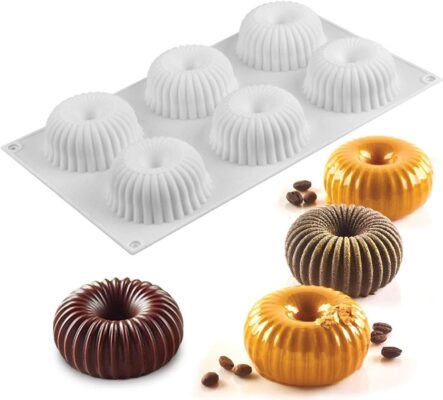
Joho 3D Silicone Baking Molds

Silikomart HONORE Silicone Mold
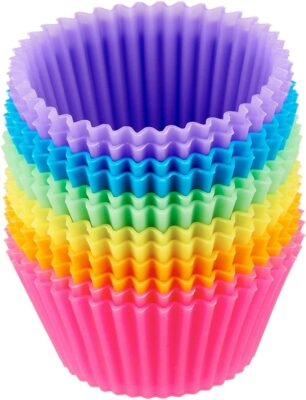
Amazon Basics Reusable Silicone Baking Cups
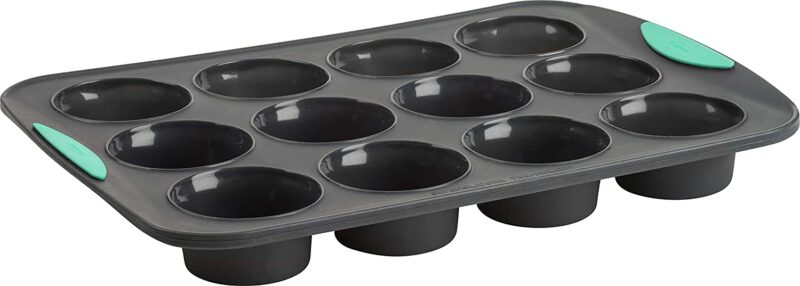
Trudeau Structured Silicone Muffin Pan
Do You Have to Grease Silicone Pans?
When it comes to baking with silicone pans, the question of whether or not you need to grease the pan is a common one.
The good news is that, in most cases, silicone pans do not need to be greased before use. This is because silicone has a naturally non-stick surface, which makes it easy to remove baked goods from the pan without sticking.
However, in some cases, greasing a silicone pan can be helpful to ensure that your baked goods turn out perfectly.
For example, if you are baking pastries or cakes, a light coating of oil or butter can help to ensure that pastries or cakes release from the pan easily and do not stick.
So, if you do decide to grease your silicone pan, what is the best way to do so?
One option is to use a spray oil, such as cooking spray, which can be evenly distributed over the surface of the pan to create a light, non-stick coating. Another option is to brush the surface of the pan with oil or melted butter, using a pastry brush or your fingertips to spread the grease evenly over the surface.
Regardless of which method you choose, it’s important to be mindful of the amount of grease you use.
Too much grease can cause your baked goods to brown unevenly, and can even affect the texture and flavor of the final product. A light coating of oil or butter is usually enough to provide the non-stick properties you need without overloading the pan with grease.
Why Is Silicone Used in Baby Products?
Silicone is a popular material for baby products due to its unique properties that make it ideal for these types of products.
One of the main reasons why silicone is used in baby products is its safety. Silicone is non-toxic and does not contain any harmful chemicals, making it a great choice for products that will come into contact with delicate baby skin.
Another benefit of silicone is its durability. Silicone products are very durable and flexible, which makes them ideal for products that need to withstand frequent use and be easy to handle.
For example, silicone baby bottle nipples are soft and flexible, making them comfortable for babies to suck on, and they are also very durable, making them ideal for long-term use.
In addition, silicone is easy to clean and maintain, which is important for baby products that need to be washed frequently.
Silicone is non-porous and does not absorb liquids, making it resistant to odors, stains, and mold. This makes it a great choice for products that will come into contact with food or water, such as baby bibs, teething toys, and bath toys.
Silicone can withstand high temperatures, making it ideal for baby products such as bottle nipples, pacifiers, and feeding spoons. This also means that silicone products can be sterilized easily, providing peace of mind for parents who want to ensure the cleanliness and safety of their baby’s products.
Finally, silicone is environmentally friendly and can be recycled at the end of its life, making it a great choice for parents who are looking for eco-friendly baby products.
Best Favorite Food-grade Silicone Based Baby Products
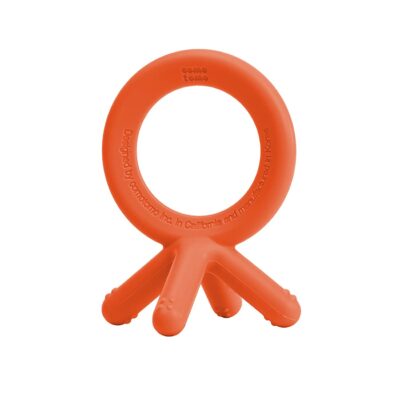
Comotomo Silicone Baby Teether
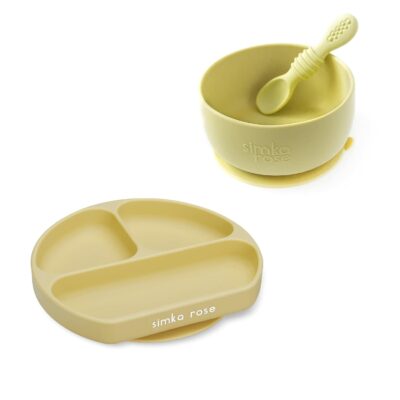
Simka Rose Silicone Baby Feeding Set
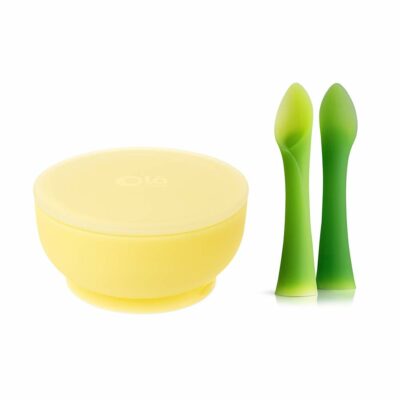
Olababy Silicone Training Spoon and Suction Bowl with Lid Bundle

WeeSprout Silicone Baby Food Freezer Tray

WeeSprout Silicone Suction Bowls
How is Silicone Better Than Plastic?
Silicone and plastic are two common materials used in a variety of products, but there are several key differences that make silicone a better choice in certain situations.
Firstly, silicone is non-toxic and does not contain any harmful chemicals such as BPA, phthalates, and PVC, which can be found in some plastic products.
Additionally, silicone is more durable and flexible than plastic. It can withstand high temperatures, making it ideal for use in bakeware, oven mitts, and other kitchen products.
Another benefit of silicone is that it is easy to clean and maintain. In terms of environmental impact, silicone is a more sustainable choice than plastic. Silicone is also biodegradable and does not release harmful chemicals into the environment when it breaks down.
Finally, silicone has a sleek and modern appearance that can enhance the look of products in the kitchen, bathroom, and other areas of the home. This can make silicone products a more attractive option compared to plastic products.
Is Silicone Recyclable?
Yes, silicone can be recycled, but it is a more challenging material to recycle compared to other materials like glass and aluminum. The recycling process for silicone typically involves grinding it into small pieces and purifying it to remove any contaminants. This purified silicone can then be used to make new products.
However, the recycling of silicone products is not widespread, and many recyclers do not accept silicone items. This is partly due to the difficulty in processing it and the lack of demand for recycled silicone.
Best Silicone Food Containers
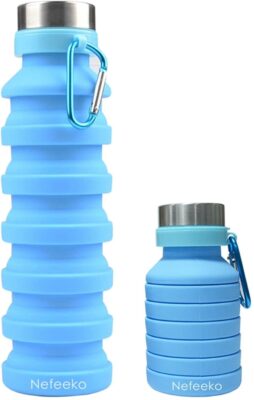
Nefeeko Collapsible Water Bottle
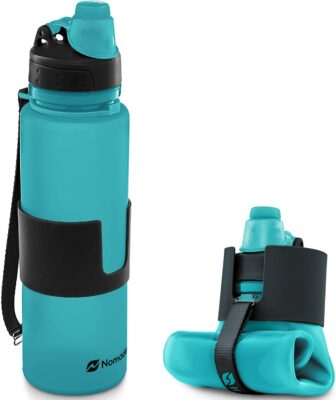
Nomader Collapsible Water Bottle
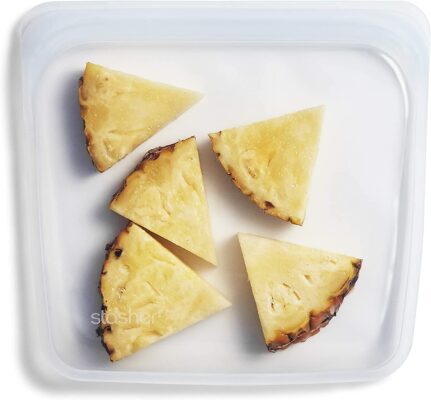
Stasher Silicone Reusable Storage Bag
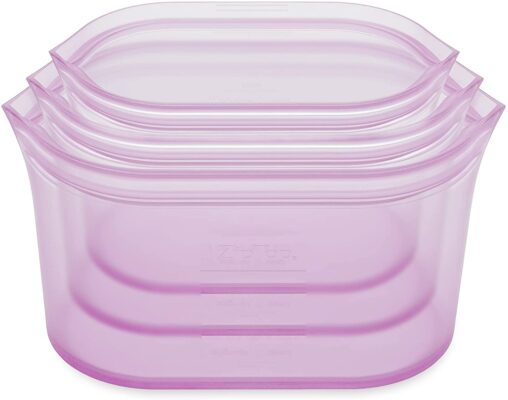
Zip Top Reusable Food Storage Bags
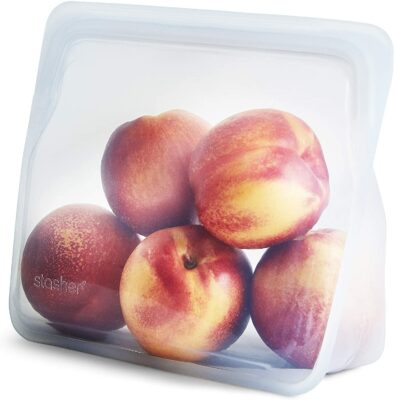
Stasher Silicone Reusable Container
Conclusion
As you can see, this material is very versatile and has many applications around the home. It is non-toxic and it doesn’t stick, which means you can use it without having to worry about cleaning up messy residue. With the information above and a bit of imagination, the uses for silicone should be limitless.
